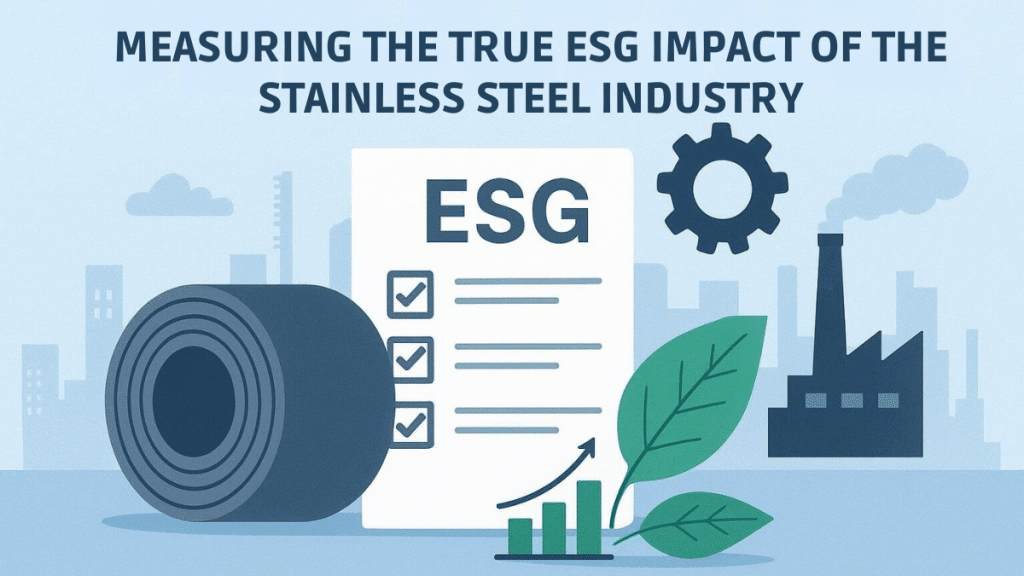The stainless steel sector sits at the intersection of heavy industry and sustainable development. With its role in infrastructure, transportation, and consumer goods, the industry carries significant weight when it comes to environmental, social, and governance (ESG) performance.
Yet, measuring the true ESG impact of the stainless steel industry is not as straightforward as it may appear. Numbers, ratios, and sustainability reports only scratch the surface. The reality is far more complex, requiring a closer look at how companies operate, innovate, and respond to global challenges.
Why ESG Measurement Matters in Stainless Steel
The demand for stainless steel continues to grow, driven by construction, automotive, energy, and urban infrastructure. However, steelmaking is energy-intensive, and this puts the industry under scrutiny. Governments, investors, and customers increasingly ask: how sustainable are these operations, and are the commitments real or just symbolic?
A stainless steel manufacturing company in India must now balance growth with accountability. To investors, ESG performance is no longer a nice-to-have; it directly affects access to capital and long-term market positioning.
Environmental Factors and Their Real Weight
When considering environmental impact, energy use and emissions dominate the conversation. Stainless steel production involves mining, smelting, refining, and recycling—all resource-heavy processes.
The real test of ESG measurement lies in three main areas:
- Carbon Emissions: Tracking Scope 1, 2, and 3 emissions provides transparency, but many reports fail to capture the indirect emissions embedded across the supply chain.
- Water and Waste Management: Beyond emissions, water recycling, waste reduction, and slag management reveal whether sustainability goals are embedded into operations or remain on paper.
- Circularity: Stainless steel is inherently recyclable. However, the percentage of scrap used in production varies widely among producers, making it a crucial metric to assess.
It is here that companies like Jindal Stainless Steel stand out, as they have begun scaling scrap utilization and renewable energy adoption. These steps are meaningful indicators of environmental progress.
Challenges in Environmental Measurement
Although metrics exist, no universal framework applies consistently across regions. What counts as renewable in one country might not meet the same standards elsewhere. Similarly, the weight of recycled content differs across plants. This makes direct comparison between producers difficult and often misleading.
Social Dimensions: Beyond Compliance
The social side of ESG is often harder to quantify, yet it is central to the true impact of the stainless steel industry. Workforce safety, diversity, and community engagement fall into this domain.
Large producers typically highlight workplace safety statistics, accident-free days, and community programs. These are necessary benchmarks. But to understand genuine progress, one must examine whether initiatives are long-term commitments or one-off projects designed for annual reporting.
For instance, some companies are moving beyond compliance by providing skills training for future jobs in renewable energy and advanced manufacturing. This creates a multiplier effect—not just protecting current employees, but also preparing local communities for future economic shifts.
Social Metrics That Should Not Be Ignored
- Health and safety performance
- Employee training and upskilling programs
- Gender and diversity ratios
- Local community investments and long-term benefits
Governance: The Often Overlooked Pillar
When evaluating ESG, governance is sometimes treated as a formality. Yet, without solid governance, environmental and social promises remain unenforceable.
Governance in the stainless steel sector involves:
- Transparent reporting of ESG data without selective disclosure
- Independent audits and third-party certifications
- Clear accountability structures at board and executive levels
- Anti-corruption measures in procurement and supply chain
For an industry with global supply chains, governance also extends to ethical sourcing of raw materials. Responsible mining, labor conditions, and vendor compliance all contribute to measuring true impact.
Why Standardized Frameworks Fall Short
Global ESG frameworks such as GRI, SASB, and TCFD provide benchmarks, but they cannot capture local realities. For example, a stainless steel manufacturing company in India may report under these frameworks, but the actual regional challenges—such as water scarcity, labor demographics, or local energy infrastructure—require contextual understanding.
This is where investors and regulators must look beyond checklists. Instead of box-ticking exercises, meaningful ESG assessment should combine standardized metrics with local insights.
Measuring the True ESG Impact of the Stainless Steel Industry
So, how can stakeholders actually measure the true ESG impact? A combination of quantitative and qualitative measures is required. Numbers alone don’t tell the full story, and narratives without data lack credibility.
Key considerations include:
- Consistency of Reporting: Are the same metrics tracked year after year?
- Third-Party Validation: Are claims audited independently?
- Long-Term Roadmaps: Do targets extend beyond annual cycles?
- Integration into Strategy: Is ESG linked with business decisions, investments, and R&D?
These questions highlight whether ESG is a genuine part of a company’s DNA or simply a public relations exercise.
FAQs
Why is ESG particularly relevant to the stainless steel industry?
Because stainless steel production is energy-intensive, its environmental footprint is large. ESG ensures accountability while guiding companies toward sustainable practices.
Can stainless steel be considered sustainable?
Yes, stainless steel is highly recyclable and durable, which makes it more sustainable than many alternative materials. However, production methods still determine overall impact.
What role does recycling play in ESG measurement?
Recycling reduces raw material extraction and energy use. Higher scrap utilization rates directly improve ESG performance.
How do Indian companies compare globally in ESG reporting?
Leading players such as Jindal Stainless Steel are aligning with international standards, though gaps remain in transparency and uniform adoption across the industry.
Conclusion
Measuring the true ESG impact of the stainless steel industry requires moving beyond surface-level disclosures. Investors, regulators, and consumers must focus on both the tangible numbers and the strategic intent behind them. The industry’s inherent recyclability is an advantage, but its heavy reliance on energy remains a challenge.
For any stainless steel manufacturing company in India or abroad, the real test lies in whether sustainability goals are consistently integrated into operations, governance, and social commitments. Only then can ESG reporting shift from compliance to genuine transformation, shaping an industry that balances profitability with responsibility.
